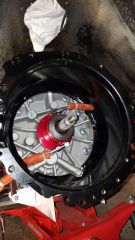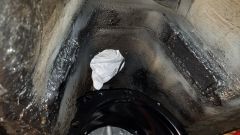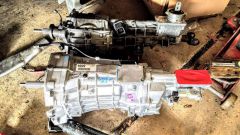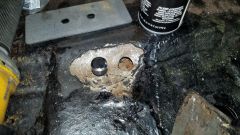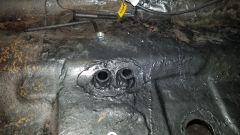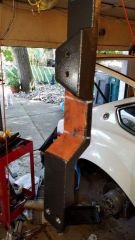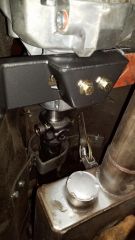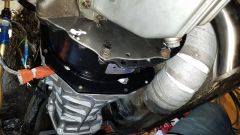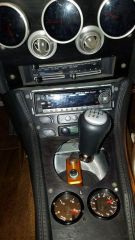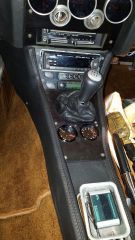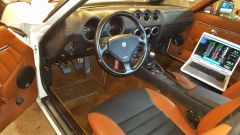-
Posts
2521 -
Joined
-
Last visited
-
Days Won
6
Content Type
Profiles
Forums
Blogs
Events
Gallery
Downloads
Store
Everything posted by TimZ
-
Hi Steve... This is what is not making sense to me - you offset grind the crank in order to modify its stroke - presumably to increase the stroke, which doesn't help the Rod to Stroke ratio unless you desire it to be smaller. Decreasing the stroke by this means also wouldn't make sense since shorter stroke cranks are already available without modification. Usually you accommodate a longer rod by raising the pin location in the piston.
-
Hi Steve... unless I'm misreading, offset grinding the crank is done to increase it's stroke, not to adjust the rod/stroke ratio. For a given stroke and rod the ratio will be the same regardless of whether you acheived the stroke by offset grinding or not. Or are you saying that he's offset grinding your LD crank for even more stroke? That of course would be making getting a decent ratio even more difficult. You're pretty much stuck with having to fiddle with the wrist pin height in the piston (or increasing the deck height which is even more complicated) if you want to use a longer rod _and_ increased stroke. This is most likely going to be what forces you down the forged piston route - it you can't find a decent hypereutectic piston that happens to have the pin height that you want you'll have to go custom, and I don't think I've seen anybody offering custom cast pistons...
-
I _have_ seen cam cards where the 0.050" events were to be measured at the cam instead of at the valve, even though it said nothing about this and everything else was measured at the valve. The results of this are consistent with what you are describing -perhaps try repeating your measurements using 0.075" (0.050" x 1.5 rocker ratio) lift at the valve and see if they make more sense.
-
...so is this the _same_ motor rebuilt and bored 0.040" over, or is it a different motor/head? Your description sounds like it's two different motors, but it's not clear. Do you know what the cam/cam timing was for both motors? It's possible that the cam was advanced on the Senza motor with respect to where it was timed on the new motor, which could also result in torque curve differences.
-
L28 head studs are 10mm - I thought the diesel was 12mm.
-
Some people remove/disconnect the heater core, usually in an attempt to make a lightweight race car, or to remedy a malfunctioning/leaking heater core or leaking interior hoses. For some reason many who do this decide that it would be a really good idea to connect the two water lines for the now missing heater core together to make a loop. To make a long story short it isn't a good idea. Tony and JeffP actually went to the trouble of proving this via instrumented, controlled testing on an engine dyno, and STILL the idea won't die and people loop the heater core lines. If you still have the heater core in the system, then this should not apply to you.
-
I've been running their straight NPG (was NPG-R before they discontinued it). I'm running the 7psi cap and a 185 deg thermostat. I did also convert to the diesel water pump, just to get some extra flow - the straight NPG has a bit lower thermal capacity but the much higher boiling point made it worth the effort. It's been working great for me for some time now.
-
I guess it's not that big of a deal, but I've been noticing otherwise unformatted text in my posts end up being links to random products on amazon once the post is submitted. They pretty much never have any relevance to the context of the post - wtf?
-
It's the close ratio trans, so 5th gear is 0.8 Actually I did not index the bell - probably should have in retrospect, but they had spent a lot of time CMM-ing my T5 bell, so I think it probably received more scrutiny than usual. Time will tell, but it went together with no issues and it's dead quiet in every gear so far...
-
Okay - sorry it's taken me a while to get back around to this - life has a way of getting in the way! So Quicktime did get me the bellhousing - and accidentally forgot to drill the engine side flange for the L-series and not the RB. As I mentioned before I didn't even get a chance to look at it for about a month, but they took care of it no questions asked. It did cause some extra delays, though. The fixed bellhousing came out really nice and fits perfectly. I ended up going with a close ratio T56 Magnum from Liberty's gears, modified with an F-body tailhousing - here's a pic of it, next to my old GForce T5: And one with the bellhousing attached: I ended up going with the F-body tailhousing due to fears that a shifter like the one mentioned above would limit how high the trans could sit in the tunnel. As it turns out it _probably_ would have been okay. I ended up using an MGW F-body shifter - with its adapter block rotated 90 degrees it actually locates the center of the shifter about an inch forward which put it pretty much right where the T5 shifter used to be, at least longitudinally. One thing I didn't count on was that the shifter housing on the F-body tail is offset a bit left from center: This ended up working out okay, but it was really close to interfering with the center console hole location that I had been using with the T5. I used a McLeod slip on hydraulic TOB: As you can see, the T56 is quite a bit larger than the T5 and I had to make some accommodations - the old mounting ears had to be cut out, as the T56 would not fit between them, and I had to do a bit of hammering to make sure that everything would clear: This of course left me needing a new rear crossmember - Ausin Hoke was gracious enough to rush me one of his first 280Z T56 crossmembers. Here's a few more pics with everything installed: And the final product (all new interior too!) Had it out today for it's fist long drive and I'm really happy with this trans so far. The MGW shifter along with the mods that Liberty's did resulted in the shifts being really precise and quick. Also the 0.62 6th gear is pulling just fine above ~45mph with my supposedly "undriveable" low compression 3 liter.
-
Completely agree. They never actually test a viscous clutch like we run, either. The stock viscous clutch seems to "de-clutch" more effectively than they show in that video. Honestly I've gone back and forth with electric fans over the years on my Z and finally just said "f it" and put the stock fan back in and never looked back. I have never been able to detect a seat of the pants difference - I seriously doubt that you are losing more than 5hp with this setup, and Chickenman has already outlined pretty thoroughly the advantages regarding reliability and reduced complexity. Also I think that the Taurus fan appears to work great with V8 conversions, but you might have trouble fitting one on an L-series, especially if you've gone with a thicker radiator. There isn't that much room between the water pump and the rad, and the Taurus fan's motor is pretty big. I'm currently running a Delco 12si 140A alternator, btw. Had to use an adapter to mount it, and when you go higher in current capability you also need to address the current capacity of the harness wiring, as it was _not_ designed for anywhere near that much current, and it's 40 years old to boot. Not advisable to actually start trying to push 90+ amps through it.



